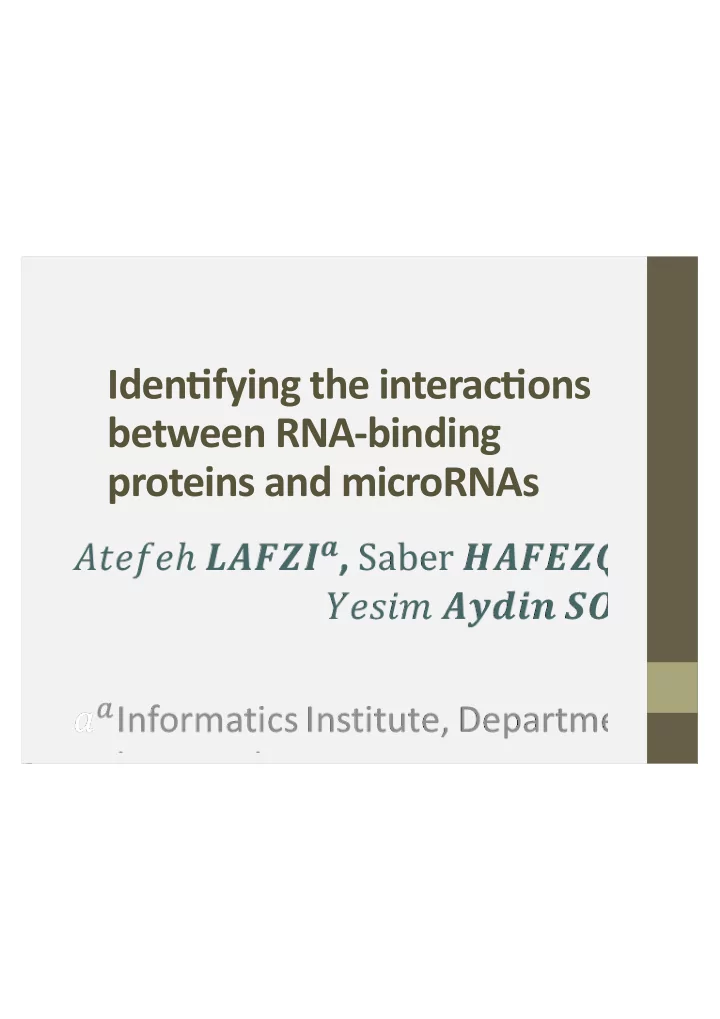

Iden%fying*the*interac%ons between*RNA7binding proteins*and*microRNAs ! ! !
Central Central Dogma Dogma ! 2 !
Post-transcriptional regulation Post-transcriptional regulation ! miRNA RBP 3 !
Role of RBPs and miRNAs in human Role of RBPs and miRNAs in human diseases diseases • RBPs RBPs: : Disease RNA)Binding)Protein ! Fragile!X!syndrome Fmr1 ! Spinal!muscular!atrophy SF2/ASF ! ! • miRNAs miRNAs: : ! Disease RNA)Binding)Protein ! Breast!cancer miR<125b,!miR<145,!miR<21,!miR< 155,!miR<210 ! Lung!cancer miR<155,!let<7a ! Alzheimer’s!disease miR<29b<1,!miR<29a,!miR<9 ! Parkinson’s!disease miR<30b,!miR<30c,!miR<26a,!miR< 133b,!miR<184 ∗ ,!let<7 4 ! !Oostra!et!al.!Biochim!Biophys!Acta,!2009 Cartegni!et!al.!Nature!Gene=cs!2002 Li!et!al.!Genomics,!Proteomics!&!Bioinforma=cs!2012
RNA-binding proteins (RBPs) RNA-binding proteins (RBPs) • There are ~850 RBPs in human. • They bind to short regions (4-12 nts) on mRNAs. • RBPs play important roles in: ! • splicing •polyadenylation • mRNA stabilization • mRNA localization • translation 5 ! !
microRNAs microRNAs • There are >1000 miRNAs in the human genome. • A microRNA is a small non-coding RNA molecule (~ 22 nts long) found in plants, ! animals, and some viruses • They affect stability and translation of their target mRNAs. 6 ! ! Vella,&M.C.&and&Slack,&F.J.&C.&elegansµRNAs,&Wormbook.&ed !
RNA secondary structure RNA secondary structure • RNA does not stay single stranded within the cell. ! • Instead it folds into complex structure where base pairs form between 7 ! complementary nucleotides Fukunaga'et'al.'Genome'Biology'2014 !
Our Goal Our Goal • Most of the current methods or analysis consider a single factor (RBP or miRNA) at a time. • We are going to investigate cooperative and competitive interactions between RBPs and miRNAs. ! • Here’s an example for a cooperative interaction: ! 8 ! Kedde$et$al.$Nature$2010
Mapping binding sites of RBPs and Mapping binding sites of RBPs and miRNAs on human 3’UTRs miRNAs on human 3’UTRs ! RBPs RBPs • RNACompete motifs ! • RNAcompete data is available for 200 RBPs from several organisms miRNAs miRNAs • TargetScan predictions 9 ! •PicTar predictions Ray$et$al.$Nature$2013 Anders$et$al,$Nucleic$Acids$Res.$2012 Lewis$et$al.,$2005$and$$Grimson$et$al.,$2007 !
Predicting the structure of 3’UTRs Predicting the structure of 3’UTRs • Experimental determination of RNA secondary structure is still difficult. • An alternative way is to use computational methods to predict RNA secondary ! structure. • RNAfold • RNAfold method predicts secondary structures of single stranded RNA based on minimum free energy • For each site we calculate the probability of being in a paired region 10 ! !
Classifying sites according to secondary structure: a) Inaccessible (Paired) Inaccessible (Paired ) b) Accessible (Unpaired) c) Complementary % ! Not$a$binding$site$for Binding$site$of any$factor a$factor 11 ! mRNA
Classifying sites according to secondary structure: a) Inaccessible (Paired) b) Accessible (Unpaired Accessible (Unpaired) ) c) Complementary % ! 12 ! mRNA
Classifying sites according to secondary structure: a) Inaccessible (Paired) microRNA RBP b) Accessible (Unpaired) Site Site c) Complementary Complementary RBP ! ! RBP 13 !
Explaining the effects of PUM sites • Zhao et al. have measured the stability of 3000 160nt long segments that are selected from conserved regions of human 3’UTRs. • We analyzed the Supplementary Figure 7 of this paper which shows mutation effects on mRNA ! stability. ! 14 ! Zhao%et%al.%Nature%Biotechnology%2014
Explaining the effects of PUM sites SIPA1L2 This figure shows the mutation results of a segment of 3’UTR of SIPA1L2 gene . ! • PUM binds to positions 51:57 • HuR binds to positions 134:140 Inaccessible ! ! Accessible " " Complementary ! ! #$% 15 !
Explaining the effects of PUM sites PUM$Binding$site SIPA1L2 This figure shows the mutation results of a segment of 3’UTR of MYOD1 gene . ! ! • PUM binds to ! positions 51:57 • CPEB4$Binding$site CPEB4 binds to positions 34:40 Inaccessible ! ! Accessible " " Complementary ! ! 16 ! #$%&'
Explaining the effects of PUM sites AKAP2 : This figure shows the mutation PUM RBM41 results of a segment of 3’UTR TUT1 of AKAP2 gene. • PUM binds to positions ! 123:129 • RBM41 binds to positions 128:134 • Inaccessible ! ! TUT1 binds to positions 126:132 Accessible " " ! Complementary ! ! 17 ! Compe22on RBM41, #$#% #$#%
Comparing sites with distinct structural contexts • Zhao half life data for clones on Beas cell line are scanned for RBPs and miRNAs binding site and the structure is predicted by RNAfold. • For each factor (RBP or miRNA) we classify the clones into ! 5 distinct groups: A. mRNAs that have inaccessible sites for the factor, this site is not complementary to another factor's site and there is no accessible site of this factor. B. mRNAs that have at least one accessible sites for the factor C. mRNAs that have complementary sites for the factor 18 ! and not having any accessible sites for the factor D. mRNAs that have no site for the factor E. mRNAs that have any site for the factor
Results for IGFBP1-3 ! • (Ig%p''IS'A'KNOWN'STABILIZING'factor'and'we'validate'this'with'our'results. 19 ! • In'the'future'we'are'planning'to'analyse'the'factors'that'ig%'is'interacEng'with.) mRNA'half'life'in'Beas'cell'line
Conclusion • We have developed a model that considers sites of all known RBP and microRNA sites concurrently to explain post- transcriptional mechanisms. ! • Using this model, we can explain the sites that are functional / not functional. •In the future, we will combine this model with transcriptional effects to explain differential gene expression in cancer. 22 !
Acknowledgement • This study has been supported by Tubitak (Scientific and Technological Research Council of Turkey) grant #113E159 ! ! 23 !
! ! ! 24 !
Recommend
More recommend